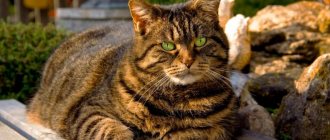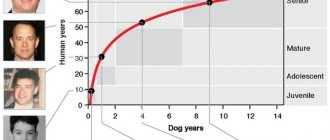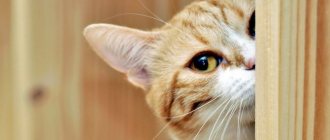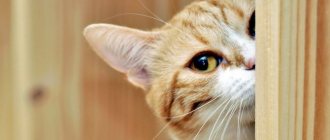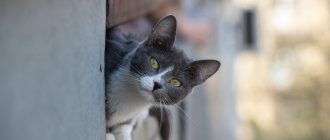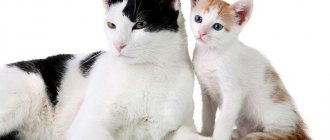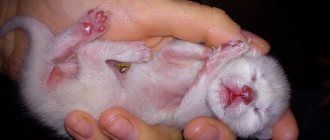Cat age chart by human standards
In the first year of life, kittens develop at a rapid pace. During this time, they manage to switch from milk to adult food, increase their body weight several times and reach puberty. Therefore, experts have developed a table that can be used to accurately convert a cat’s age to human age, taking into account the physiological characteristics of development.
| Kitten age | Human age, years |
| 0-1 month | 0-1 |
| 2-3 months | 2-4 |
| 4 months | 6-8 |
| 6 months | 10 |
| 7 months | 12 |
| 12 months | 14-15 |
After 12 months, the development of animals occurs without significant jumps. Therefore, determining the age of a cat by human standards is even easier.
| Age of the cat | Human years |
| 1 year | 18 |
| 2 years | 20 |
| 3 years | 25 |
| 4 years | 30 |
| 5 years | 35 |
| 6 years | 40 |
| 7 years | 45 |
| 8 years | 50 |
| 9 years | 55 |
| 10 years | 60 |
| 11 years | 64 |
| 12 years | 68 |
| 13 years | 72 |
| 14 years | 76 |
| 15 years | 80 |
| 16 years | 84 |
| 17 years | 88 |
| 18 years | 92 |
| 19 years | 96 |
| 20 years | 100 |
Why do you need to know the age of cats?
The desire to find out what stage of life a pet is at is not just idle curiosity for most owners. Determining the approximate age helps to adjust the animal’s lifestyle, since each period has its own nuances. For example, the older the cat, the less physical activity its body can withstand. But young kittens cannot do without regular active games.
Since cats, like people, decline in health over the years, they become more susceptible to various diseases. Accordingly, care for older pets should be more thorough than for young animals. The choice of diet also depends on how old the pet is. For example, older cats whose teeth are already worn out find it difficult to chew rough food or dry food.
Determining the age of a pet
So, by calculating a cat’s age by human standards, you can not only improve the pet’s quality of life, but also make it a long-liver. As practice shows, with proper care and maintenance, cats can live up to 15, and sometimes even more, years.
Life stages of cats
Research results have shown that a cat's life is divided into certain periods. Each of them has individual physiological, psychological and behavioral characteristics.
Throughout their lives, cats go through the following stages of development:
- The period of infancy. Kittens are born deaf and blind, but literally after a couple of weeks they open their eyes and begin to hear. And from 30 days they actively move around the apartment, studying its environment.
- Childhood. This stage is considered the most important in the life of kittens and lasts up to six months. At this time, they are actively growing and learning about the world around them. During childhood, kittens develop their character and strengthen their immunity.
- Youth. This stage begins at six months. At this time, kittens every day more and more resemble adult animals, but in terms of their level of development they are considered children. They are actively growing and making their first serious attempts to defend their positions when communicating with their brothers. At 8-10 months, kittens reach puberty. Around this time, cats begin their first heat, and cats begin to need to mark their territory. Despite the fact that during adolescence, the hormonal system of adolescents works like that of adult animals, they continue to develop and are not fully ready to reproduce.
- Youth. This stage occurs after reaching physiological maturity and lasts up to 5 years. At this time, cats are full of strength and energy, but do not yet have enough experience.
- Maturity. This period of development begins at 6 years and ends at 9-10. Cats of this age group are quite smart and calm. They have a fully formed character and it is difficult to get rid of stable habits.
- Old age. It begins at the age of 9-11 and is accompanied by a gradual deterioration in the functioning of the body. At this age, cats experience a decrease in metabolic rate and various diseases appear.
Ratio considering approximate conversion factor
| Age of cat or cat, years | Approximate conversion factor | Correlation with human, years |
| 1/12 | 7 | 6-7/12 |
| 2/12 | 5.5 | 10-11/12 |
| 3/12 | 8-8,6 | 2-2.5 |
| 4/12 | 15-15.5 | 5-5.5 |
| 5/12 | 20 | 8-8.5 |
| 6/12 | 28-30 | 14-15 |
| 7/12 | 26-26.5 | 15-15.5 |
| 8/12 | 24-24.8 | 16-16.5 |
| 1 | 18-19 | 18-19 |
| 2 | 12.4-13 | 25-26 |
| 3 | 10-11 | 30-33 |
| 4 | 8.8-9.2 | 35-37 |
| 5 | 8-8.5 | 40-43 |
| 6 | 7-7.5 | 43-46 |
| 7 | 6.4 | 46-47 |
| 8 | 6.25-6.6 | 50-53 |
| 9 | 6.1-6.4 | 55-58 |
| 10 | 6-6.3 | 60-63 |
| 11 | 5.6-5.9 | 63-65 |
| 12 | 5.4 | 65-68 |
| 13 | 5.2-5.5 | 68-71 |
| 14 | 5.1-5.2 | 72-73 |
| 15 | 5 | 74-75 |
| 16 | 4.8 | 76-77 |
| 17 | 4.6 | 78-79 |
| 18 | 4.4-4.7 | 80-85 |
Often, correct calculation and comparison does not give the correct results. This is explained by various reasons. For example, one of them is the animal’s lifestyle.
Sexual activity also matters. It has been proven that when male cats lack the ability to realize their sexual instincts, a hormonal imbalance occurs in their bodies. And this entails a deterioration in the condition of bones, teeth, and the functioning of internal organs. These pets age quickly, making it difficult to calculate their average age in human terms.
It is generally accepted that a cat’s body can begin to age after the animal celebrates its fourth birthday. Stress and emotional stress, as well as poor nutrition, contribute to this. Often it is the owner’s laziness that results in loss of smoothness and silkiness of the coat, tooth loss and the accumulation of tartar. The animal's diet must be balanced and complete. He needs not only nutrients, but also vitamins and microelements.
Determining the age of a cat by external signs
If the cat does not have documents and came into the house as an adult, you can find out the approximate number of years she has lived by her appearance:
- According to the condition of the teeth. This is the most accurate way to determine a cat's age. A one-month-old kitten already has baby teeth. At the age of six months they are completely replaced by the indigenous ones. By 18 months, grinding of the central lower incisors begins. By the age of 2 years, yellow discoloration appears on the tooth enamel. In five-year-old cats, the incisors noticeably wear out and the fangs begin to deteriorate. At the age of 9, cats have almost completely worn down all their lower teeth, and by the age of 10, their upper teeth are worn down. By age 15, many animals have lost most of their teeth.
- According to the condition of the coat. Until about 7 years of age, all cats have a healthy, shiny coat without bald spots or gray hair. From the age of eight, the quality of wool begins to deteriorate. The hairline loses its natural shine and becomes thinner. Often at this age, cats develop bald spots, mats and gray hair.
- According to the condition of the musculoskeletal system. During the period of youth and maturity, cats have prominent muscles, ease of movement and increased endurance. After 8 years of age, animals begin to experience a decrease in muscle tissue volume and a noticeable decrease in activity. At this age, cats' spine sags, their shoulder blades protrude, and their movements become stiff.
- According to the condition of the eyes. This is the most unreliable way to calculate a cat's age. The eyes of adolescents and adult animals are practically no different from each other. And only by the age of 10 can one notice signs of aging. At this age, the iris becomes blurry, faded and cloudy.
On a note. All these methods allow you to approximately calculate the age of a cat. But when using them, it is necessary to take into account the living conditions, health and nutritional quality of the animal.
Indicators of cat age
Determining the age of an animal is much more difficult if you just took it from the street or took it from a shelter. In cases where you do not know the exact date of birth of a cat, some features will help you, according to which veterinarians are able to calculate the approximate age of the animal:
- Cat's teeth. Thanks to them, you can clearly understand the approximate age of your pet. Older cats tend to have darker hair than younger cats. A kitten's baby teeth first appear between two and four weeks, with a more permanent set of teeth appearing around four months of age. So if you open a cat's mouth and find permanent white teeth, the cat is probably about a year old. Some yellowing on the teeth may place the cat between 1 and 2 years of age, and tartar accumulation on all teeth indicates the animal may be between 3 and 5 cat years of age. Missing teeth may mean you have an older cat on your hands.
- Muscle tone of a cat. Young cats are more likely to have better muscle mass due to their higher activity levels. Older cats tend to be a little calmer and have a little extra skin and drooping or protruding shoulder blades.
- Cat's fur coat. The condition of a cat's coat is another important indicator of a cat's age. Kittens and younger cats typically have soft, fine fur, while older cats have thicker, coarser fur. An older cat may have gray or white spots.
- Cat's eyes. Bright, clear eyes without tears or discharge are common in young cats. A cat with some blurry vision will likely be around 12 years old. While examining the lens, also look at the iris. Young cats have smooth irises, while an older cat's iris can sometimes look somewhat jagged.
How to compare the age of a cat and a person
The easiest way to calculate the age of a cat by human standards assumes that one year of a pet’s life is equal to seven human years. But this option is very unreliable and gives a very approximate result.
To make a more accurate calculation, you need to remember that the rate of growth and aging of cats is very different from that of humans. To determine the number of human years lived by pets, you need to know that:
- The development level of a three-year-old cat is equal to 25-30 human years.
- At the age of 3-5 years, this figure should be increased by 7 every year.
- In the period from 5 to 12 years - by 4.
- From the age of twelve, 1 cat year is counted as 3 human years.
There is a formula by which you can determine the age of a cat by human standards: X = 24 + ((number of years – 2) * 4). But it is only applicable for animals over 3 years old.
Monitor your cat's aging process
When calculating your cat's age in human years, it is important to understand that various factors can affect the comparative age of your cat and human. These may include variables such as heredity, diet, environment, and physical and medical care.
While it's likely that you have no say in heredity, you do have control over other factors that influence your cat's aging process. For example, if you have an older cat, you can meet their needs by exercising weekly, brushing their hair and teeth daily, and feeding them the right diet.
However, if you have a kitten, you may want to pay attention to key developmental milestones in the first eight weeks. In the first week, you will want to understand that your kitten will be born with her eyes closed and ears curled, and will weigh somewhere between 90 and 100 grams.
Around the third day, you can expect the umbilical cord to fall off. After seven days, the weight should double. Watch for your kitten's eyes to open and baby teeth to begin to form in the second week. During the third week, the ears become pointed and several kittens begin to explore their environment.
By the fourth week, you can expect more teeth and improved hearing. After weeks five to eight, you can expect your kitten to have full sight, try to eat solid food, and see changes in eye color and activity. During this time, you should prepare for your kitten's first vaccination.
Cats of any age should be closely monitored when it comes to things like development, nutrition, and vaccinations.
© shutterstock
Lifespan of cats
Cats live on average 14-16 years. Their life expectancy is influenced by many factors, including the attitude of the owners, breed, living conditions, quality of feeding and previous diseases.
Interesting! The absolute record holder for life expectancy is a cat named Cream Puff. She lived for 38 years and was included in the pages of the Guinness Book of Records.
None of the existing methods for translating the age of a cat reflects the individual characteristics of a particular animal. And in order to provide a cat with decent living conditions, it is not necessary to recalculate the years he has lived in human years.
Long-lived cats: records, breeds
Long-lived cats can live 29 years, which has documented evidence. But there are cats that lived longer and are listed in the Guinness Book of Records:
- Cream Puff from Texas (08/03/1967 - 08/06/2005), 38 years, 3 days.
- Sphynx Granpa Rex Allen, a hybrid of Sphynx and Devon, from Texas, although he was born in Paris (02/01/1964-04/01/1998), 34 years, 2 months.
Both animals lived with Texan Jake Perry. It is believed that the long life of these animals in one owner is explained by their diet: bacon, broccoli, eggs, asparagus.
But the oldest cat is considered to be Lucy, Lower Wales, England. Her age cannot be confirmed with absolute certainty. This is an ordinary yard cat, whose age its new owner tried to determine after the death of its owner. He found witnesses who confirmed that the cat was born in 1972 and in 2015 she was 43 years old.
About the importance of calculations
Drawing an analogy between the age of an animal and human years is of practical importance for proper upbringing and maintenance. Thus, many owners mistakenly believe that a six-month-old kitten is just a small child 3 to 5 years old. In fact, the baby corresponded to this childhood age at 3 - 4 months. It is important to know this feature so as not to miss the moment of raising and socializing a young animal.
If you treat a 6-month-old kitten like a child aged 10-12 years, then you can understand what is acceptable in a pet’s behavior and what is an oversight in upbringing. Through games and entertainment, a young animal should develop social behavior skills and the concept of prohibitions. At the age of one year, the attitude of household members towards a cat that is already adult in their opinion should be like that of a 15-16 year old teenager. In no case should a pet be mated until it is a year old; this is too early for the animal’s fragile psyche.
Until the age of 6, the animal is full of strength and energy and is capable of actively reproducing offspring. There are practically no health problems observed during this period. It is characterized by the animal’s greatest activity; the pet is healthy and full of energy.
After 7 - 8 years, a cat's old age begins with corresponding restrictions and problems. By this period, responsible owners sterilize or castrate the animal or stop the reproduction of offspring by other means. As a rule, it is at this age, which corresponds to 44 - 48 years of age for a person, that the animal begins to have health problems.
Keeping an elderly animal requires the owner to be attentive to health, nutritious nutrition, and proper maintenance. After 9-10 years, it is necessary to carry out routine examinations with a veterinary specialist at least 2 times a year.
How to extend the life of a pet
Wanting to know the answer to the question of how long a cat's year is considered, the owner is not just showing curiosity. First of all, such data will help prolong the life of your beloved couch potato. In order for a cat to delight family members with its presence for a long time, the owner should know how to prolong the life of a furry pet:
- For each breed, you should follow the advice and recommendations of breeders regarding housing and feeding conditions.
- Conduct routine vaccination against infectious diseases.
- If an animal is not of breed value, then to increase its life expectancy it should be castrated or sterilized at an early age.
- Regular preventive examinations by a veterinarian allow you to identify diseases at an early stage, as well as adjust housing and nutritional conditions. After 6 - 7 years, the cat should be taken to the clinic every six months, including ultrasound diagnostics of internal organs.
- Feeding your pet premium and super-premium food will prevent the development of many diseases and prolong the life of your furry homebody.
The owner, knowing how to calculate the age of a cat, will be able to avoid many mistakes in keeping a pet. Raising, caring for, feeding, and caring for the health of an animal must correspond to its age, physical and mental condition.
| Heredity | Plays an important role in the life expectancy of the animal. Genetic predispositions and diseases significantly shorten the life of furry couch potatoes |
| Reproductive activity | Outdoor cats, which mature early and produce 4 litters per year, quickly become physically exhausted. Their lifespan rarely exceeds 5 years. Scientific research shows that early spaying and neutering extends a pet's life by at least 1 year. |
| Diseases | Various diseases reduce a cat's life. Not all of them end in death, but most pathologies can significantly undermine the health of a pet |
| Nutrition | Veterinary experts say that rational and high-quality nutrition can give your pet several additional years of life. But feeding with cheap mass-market food, on the contrary, leads to a reduction in the happy years lived together |
Nutrition depending on age
At each individual period of life, cats need a certain diet. What will invigorate an active kitten, the stomach of an old pet simply cannot digest.
Owners of small kittens should definitely prepare a menu rich in vitamins for them. The diet should include fermented milk products, boiled meat and fish. The yolk is also good for babies. And vegetables and semolina will help kittens grow healthy and active.
An adult cat needs a nutritious diet no less. Depending on the breed, the menu should include meat products. Occasionally you can treat your pet to fish. But only if he is not sterilized!
Fermented milk products in small portions will help improve digestion, and porridge and boiled vegetables will saturate the animal with essential vitamins.
Elderly animals need a special menu. Due to dental problems, cats need soft or crushed food. You should also prevent your pet from becoming obese. If it’s difficult to feel the ribs on your cat’s body, then it’s time to reduce the portion. The diet of an old animal must be balanced, it must contain calcium and taurine.
